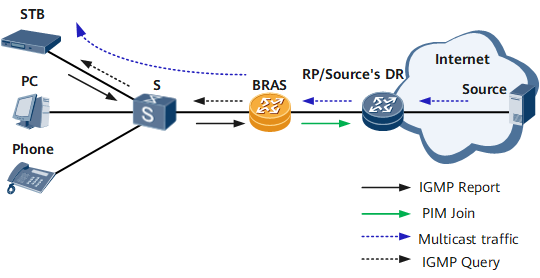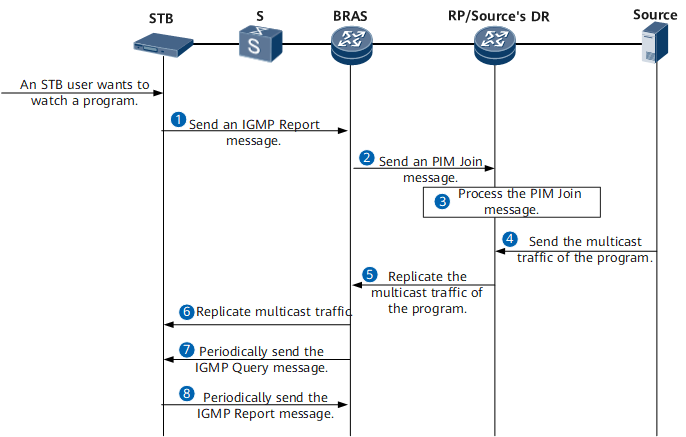Multicast Program Join
Multicast program join requires the user to be online and a member of a multicast group. In user-side multicast, only the Point-to-Point Protocol over Ethernet (PPPoE) access and IP over Ethernet (IPoE) access modes are supported, and only session-based replication is supported. As shown in Figure 1, a set top box (STB) user sends an IGMP Report message to join an IPTV multicast program. Most implementation processes are similar in PPPoE and IPoE access modes. See Table 2 for the differences between the processes.

Session-based multicast replication is used in the following illustration of the multicast program join process. Multicast program join processes of other multicast replication modes are similar to that of session-based multicast replication.
Accessing the Internet through PPPoE or IPoE is a prerequisite for users to join multicast programs. Figure 2 illustrates the procedures of multicast program join, and Table 1 describes each procedure.
Step |
Device |
Key Action |
|---|---|---|
|
STB |
To join a multicast program after going online, an STB sends to an IGMP-capable BRAS an IGMP Report message of a multicast program. Upon receipt of the message, the BRAS identifies the user and the multicast program that the user wants to join. |
|
BRAS |
The BRAS creates a multicast forwarding entry for the STB. In this entry, the downstream interface is the interface that connects to the STB. If it is the first time that a BRAS creates a multicast forwarding entry for the STB, the BRAS sends a Protocol Independent Multicast (PIM) Join message to the rendezvous point (RP) or the source's designated router (DR). |
|
RP/source's DR |
After receiving the PIM Join message, the RP or the source's DR generates a multicast forwarding entry for the STB. In this entry, the downstream interface is the interface that receives the PIM Join message. Then, the STB successfully joins the multicast group, and the RP or source's DR can send the multicast traffic to the STB. |
|
Source |
The multicast source sends multicast traffic to the RP or the source's DR. |
|
RP/source's DR |
The RP or source's DR replicates multicast traffic to the BRAS. |
|
BRAS |
The BRAS replicates the multicast traffic it receives to the STB by session based on the multicast forwarding entry. The STB user can then watch the program. |
|
BRAS |
To determine whether any members remain in the multicast group, the BRAS periodically sends an IGMP Query message to the STB. If no members remain, the BRAS tears down the group. |
|
STB |
Upon receipt of the IGMP Query message, the STB responds with an IGMP Report message to keep the multicast program active. |









